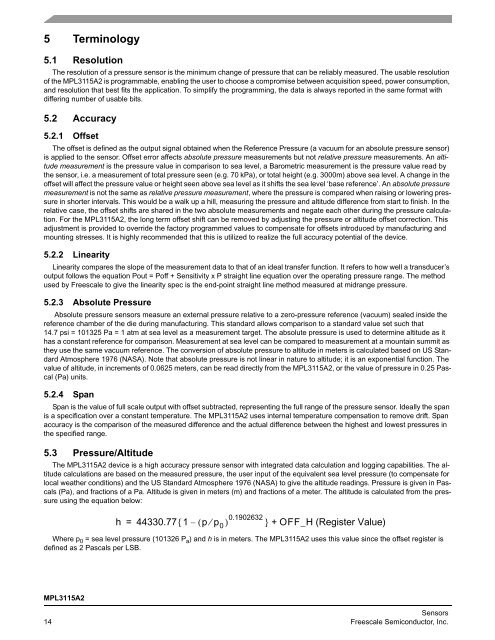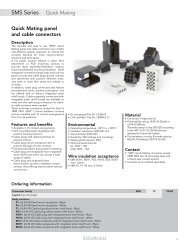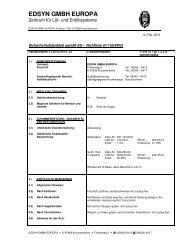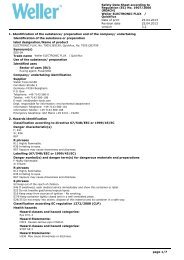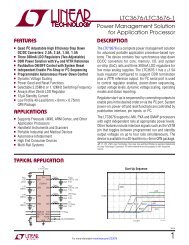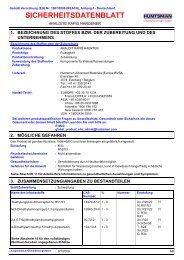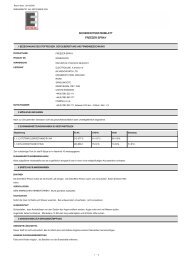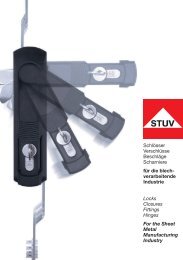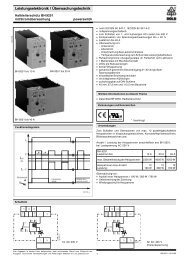I C Precision Altimeter - Farnell
I C Precision Altimeter - Farnell
I C Precision Altimeter - Farnell
You also want an ePaper? Increase the reach of your titles
YUMPU automatically turns print PDFs into web optimized ePapers that Google loves.
5 Terminology<br />
5.1 Resolution<br />
The resolution of a pressure sensor is the minimum change of pressure that can be reliably measured. The usable resolution<br />
of the MPL3115A2 is programmable, enabling the user to choose a compromise between acquisition speed, power consumption,<br />
and resolution that best fits the application. To simplify the programming, the data is always reported in the same format with<br />
differing number of usable bits.<br />
5.2 Accuracy<br />
5.2.1 Offset<br />
The offset is defined as the output signal obtained when the Reference Pressure (a vacuum for an absolute pressure sensor)<br />
is applied to the sensor. Offset error affects absolute pressure measurements but not relative pressure measurements. An altitude<br />
measurement is the pressure value in comparison to sea level, a Barometric measurement is the pressure value read by<br />
the sensor, i.e. a measurement of total pressure seen (e.g. 70 kPa), or total height (e.g. 3000m) above sea level. A change in the<br />
offset will affect the pressure value or height seen above sea level as it shifts the sea level ‘base reference’. An absolute pressure<br />
measurement is not the same as relative pressure measurement, where the pressure is compared when raising or lowering pressure<br />
in shorter intervals. This would be a walk up a hill, measuring the pressure and altitude difference from start to finish. In the<br />
relative case, the offset shifts are shared in the two absolute measurements and negate each other during the pressure calculation.<br />
For the MPL3115A2, the long term offset shift can be removed by adjusting the pressure or altitude offset correction. This<br />
adjustment is provided to override the factory programmed values to compensate for offsets introduced by manufacturing and<br />
mounting stresses. It is highly recommended that this is utilized to realize the full accuracy potential of the device.<br />
5.2.2 Linearity<br />
Linearity compares the slope of the measurement data to that of an ideal transfer function. It refers to how well a transducer’s<br />
output follows the equation Pout = Poff + Sensitivity x P straight line equation over the operating pressure range. The method<br />
used by Freescale to give the linearity spec is the end-point straight line method measured at midrange pressure.<br />
5.2.3 Absolute Pressure<br />
Absolute pressure sensors measure an external pressure relative to a zero-pressure reference (vacuum) sealed inside the<br />
reference chamber of the die during manufacturing. This standard allows comparison to a standard value set such that<br />
14.7 psi = 101325 Pa = 1 atm at sea level as a measurement target. The absolute pressure is used to determine altitude as it<br />
has a constant reference for comparison. Measurement at sea level can be compared to measurement at a mountain summit as<br />
they use the same vacuum reference. The conversion of absolute pressure to altitude in meters is calculated based on US Standard<br />
Atmosphere 1976 (NASA). Note that absolute pressure is not linear in nature to altitude; it is an exponential function. The<br />
value of altitude, in increments of 0.0625 meters, can be read directly from the MPL3115A2, or the value of pressure in 0.25 Pascal<br />
(Pa) units.<br />
5.2.4 Span<br />
Span is the value of full scale output with offset subtracted, representing the full range of the pressure sensor. Ideally the span<br />
is a specification over a constant temperature. The MPL3115A2 uses internal temperature compensation to remove drift. Span<br />
accuracy is the comparison of the measured difference and the actual difference between the highest and lowest pressures in<br />
the specified range.<br />
5.3 Pressure/Altitude<br />
The MPL3115A2 device is a high accuracy pressure sensor with integrated data calculation and logging capabilities. The altitude<br />
calculations are based on the measured pressure, the user input of the equivalent sea level pressure (to compensate for<br />
local weather conditions) and the US Standard Atmosphere 1976 (NASA) to give the altitude readings. Pressure is given in Pascals<br />
(Pa), and fractions of a Pa. Altitude is given in meters (m) and fractions of a meter. The altitude is calculated from the pressure<br />
using the equation below:<br />
h = 44330.77{<br />
1 – ( p ⁄ p 0<br />
) 0.1902632 } + OFF_H (Register Value)<br />
Where p 0 = sea level pressure (101326 P a ) and h is in meters. The MPL3115A2 uses this value since the offset register is<br />
defined as 2 Pascals per LSB.<br />
MPL3115A2<br />
Sensors<br />
14 Freescale Semiconductor, Inc.


